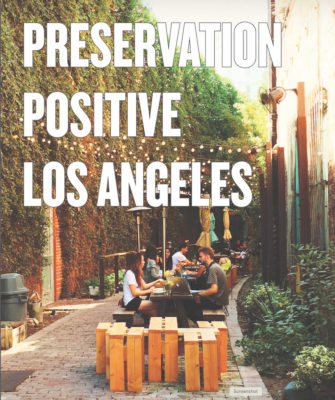On Preservation: Historic preservation protects affordable neighborhoods

NEW 47-PAGE REPORT shows how preservation
positively affects housing, affordability,
sustainability and economics.
Looking for things to do during the recent coronavirus pandemic lockdown that fell upon the city mid-March, I came upon the Los Angeles Conservancy’s recent study entitled “Preservation Positive Los Angeles.” The study was released at one of the final gatherings of the season, on March 5, at the 1928 Art Deco-style gem, the Trust Building in downtown. According to its executive summary, the study aims to provide “an in-depth look at historic preservation within L.A. and how historic places directly contribute to the overall livability of the city.”
“Preservation Positive Los Angeles” could not have arrived at a more significant time, as heightened pressure for more housing and density has often cast historic preservation in the NIMBY camp, a hindrance to development and benefiting only the well-off. The argument that the study lays out is that, in reality, data draw a much different picture. Historic preservation, it aims to prove, “plays a positive role in promoting stable neighborhoods, protecting existing affordable housing, and meeting new housing and creative office needs.”
With more than 80 percent of existing buildings in Los Angeles more than 50 years old, it is a surprise to learn that only 6.2 percent of them are deemed historic and that only 2.8 percent of historic resources have some form of protection in the form of Historic Preservation Overlay Zones (HPOZs), Historic Cultural Monument designation or National Register listing. In fact, Los Angeles lags behind other large cities with regard to designation of historic buildings. Excluding historic resources, about 93.8 percent of the area’s parcels are available for entrepreneurs’ review and potential development.
Affordable housing
It is the study’s examination of the benefits of HPOZs with regards to affordable housing, however, that is truly the highlight of the document. The city’s affordable housing crisis and its effect on the homeless epidemic make the protection of historic rent-controlled housing a necessity. Most of Los Angeles’ renters (58 percent) live in housing built before 1960, and only 43 percent of all rentals are rent controlled. Misuse of the Ellis Act has caused the loss of nearly 26,000 rent-controlled units in less than 20 years, at the same time as housing has become more expensive. Los Angeles ranks third among the most rent-burdened cities, according to the Federal Home Loan Mortgage Corporation.
Preservation, the study says, is affordable housing. Los Angeles has 35 HPOZs that hold 5 percent of the city’s stock of rent controlled units.
HPOZs have been among the best tools available to protect affordable housing. In our local area, it could be mistaken that HPOZs are mainly made up of single-family residences. However, city-wide, 69 percent of all units in historic districts are multi-family housing. HPOZs hold greater shares of affordable housing per capita than the rest of the city with 51 percent of rental units in historic districts affordable for low income two-person households and 23 percent for low-income households of four people.
Such districts also have higher percentages of families making under $25,000 a year. These figures have encouraged residential longevity, with HPOZs accounting for 5 percent of all the long-term residents in the city. Los Angeles’ HPOZs have also proven to be some of the city’s most stable neighborhoods at the same time being among the most ethnically, racially and economically diverse populations compared to Los Angeles as a whole.
“Preservation Positive Los Angeles” also covers subjects such as adding density, investing in historic properties, preservation as a cost-effective way to develop office space, and environmental sustainability and much more. My favorite section is the proposal to redevelop all of the city’s 675 strip malls to create anywhere from 60,000 to 80,000 apartments built above ground floor commercial space.
“Preservation Positive Los Angeles” is a document that is well presented and wonderfully illustrated, well worth your time to read as our HPOZs and historic resources face looming challenges with more so-called “housing” legislation on the horizon such as Assembly Bill (AB) 1279, AB 725, and Senate Bill 920 (Senator Scott Wiener’s latest repackaging of his three failed attempts) coming down the pike. The Conservancy’s study and associated documents can be found on the Los Angeles Conservancy website: www.laconservancy.org/study-preservation-positive-los-angeles.
By Brian Curran
Category: Real Estate
